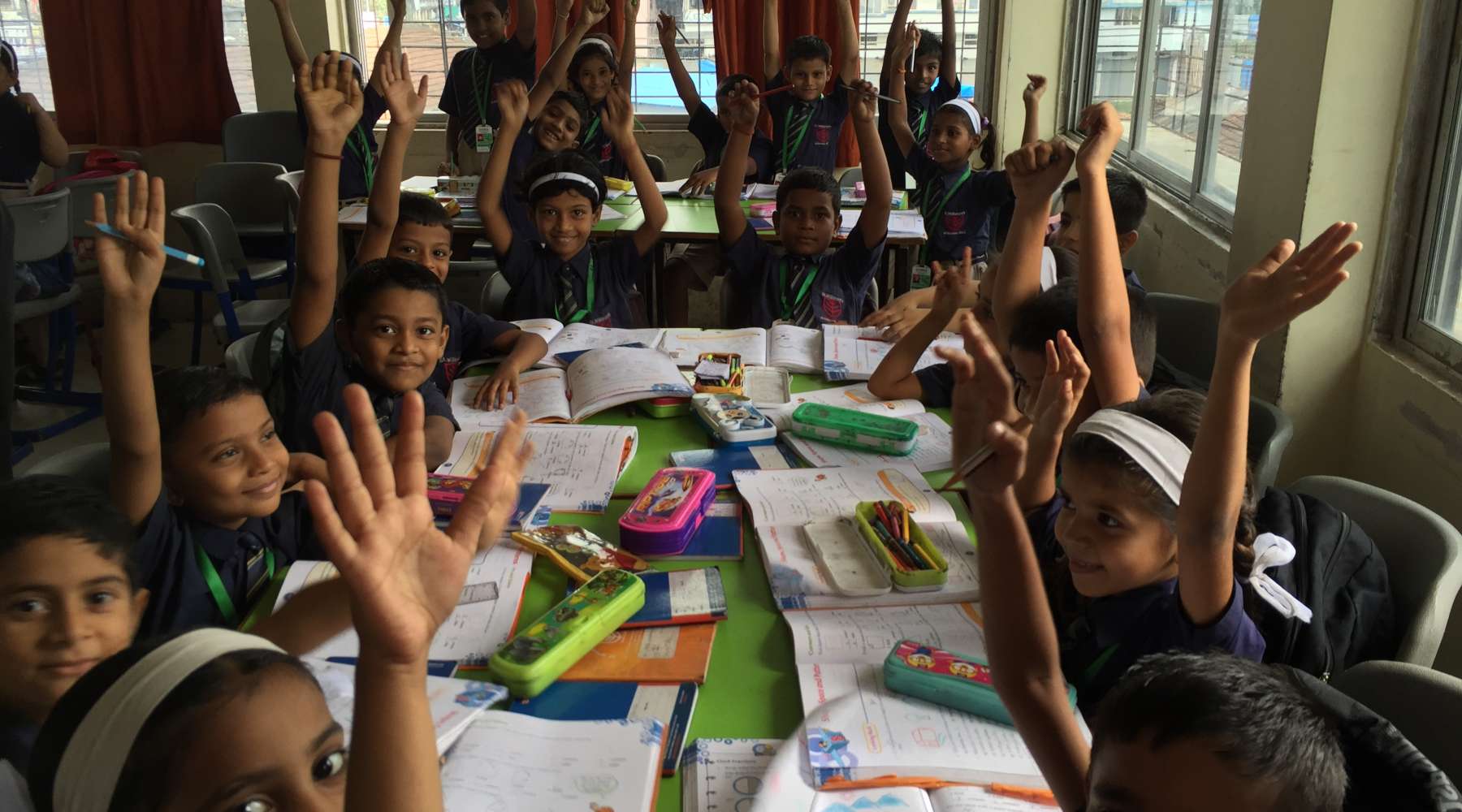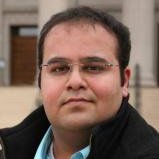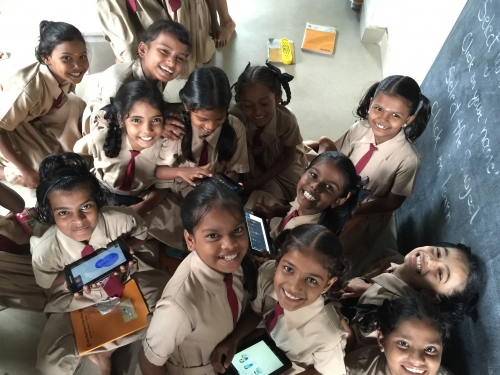
 By Avi Sethi T'16
By Avi Sethi T'16
Avi is a second-year student at Tuck who previously worked for the NewSchools Venture Fund, a Palo Alto based ed-tech seed investor. Previous to NewSchools, he worked in strategy consulting at Accenture based out of New York City. He started his career as a high school math teacher in Charlotte, NC through the Teach For America program. Avi is a proud Minnesota Golden Gopher alum. At Tuck, he is a Center for Business & Society Fellow.
It was just before 10 a.m. when we boarded the train leaving the Vashi station in Navi Mumbai. We were on our way back to Mahim, the neighborhood where Zaya’s office is located in Mumbai, India. Abhishek, one of Zaya’s school managers, invited me to join him on a school visit turned sales call at The Sacred Heart School.
It was my second week in Mumbai as part of my summer internship with Zaya, an education technology startup that is democratizing access to blended learning and online content through a full-suite of hardware, software, and analytics. The organization’s product is akin to an AppleTV but designed specifically for the classroom.
Last year Zaya received funding from the Pearson Affordable Learning Fund (PALF), the internal venture capital fund for Pearson, the world’s largest education company. PALF invests in educational startups around the world that are focused on leveling the educational playing field for the mass market. An interesting twist to my internship was that I was actually employed by PALF, but was being loaned out to Zaya for most of the summer in order to help with general strategy and business development needs.
As we boarded the train, Abishek warned me that this train might be a little more crowded than the one we had taken very early this morning to get to the school. I was sure to heed his warning this time, after I took his first one about the drainage system in Nala Sopara lightly. Nala Sopara is a lower-income northern suburb of Mumbai where monsoon season can turn the town into a shallow version of Venice, Italy. Wading through the water that day, all I could think about was an article I had read the night before about people getting sick from rat fecal matter floating in the water.
“Is this what I signed up for?” I asked myself.
The train was full, but not dissimilar from what I had experienced during the morning rush on the A-train in New York City—I figured the worst was behind me. But then, stop  after stop, more people pushed and squeezed their way onto the train. At each stop I would take a breath as maybe five people would get off, only to be drowned by an impossible ten more people squeezing in. The trains in Mumbai are designed without doors. At first, I didn’t understand why, but soon realized the lack of doors made sense when groups of people hung off the sides of the train, carefully holding onto a small railing around the doorway and maintaining their balance with just one foot inside as we roared from station to station.
after stop, more people pushed and squeezed their way onto the train. At each stop I would take a breath as maybe five people would get off, only to be drowned by an impossible ten more people squeezing in. The trains in Mumbai are designed without doors. At first, I didn’t understand why, but soon realized the lack of doors made sense when groups of people hung off the sides of the train, carefully holding onto a small railing around the doorway and maintaining their balance with just one foot inside as we roared from station to station.
“Breathtaking,” I thought to myself. But not just in the visual sense—I felt so squeezed inside the train that it was impossible to take a full breath. India’s infamous heat and monsoon season also added to the experience. It had been raining for days on end. Even when it wasn’t raining, the humidity hugged you like a wet blanket.
I thought back to Professor Joe Hall’s Operations course and how at least he would have been impressed by the train’s throughput rate. Just then, sweat started forming on my forehead. I realized I couldn’t move my arms in order to wipe it away, and naturally the small droplets began falling one-by-one onto the back of the person standing in front of me. I would have felt badly, but I was more tormented by the thought that there must be a stranger’s sweat sprinkling on my own back. I was too packed into be able to turn my head and check!
When I was recruiting for internships my first year, I wanted to find something unique; something that would stretch me in a way I had never been before. I guess this was the appropriate result. All joking aside, as a former Teach For America corps member, and then strategy consultant, I was drawn to Zaya because of the challenges existing in the education venture capital space as well as the opportunity to go abroad as part of my summer away from Tuck. Even though “ed-tech startups” are considered to be nascent opportunities with a lot of ambiguity, it turned out that Zaya was a great fit for an internship, and Tuck was the perfect sandbox for me to learn and grow in order to succeed this summer.
For one, the classes at Tuck prepared me well for the challenges I was facing. Whether it was the more benign—such as using what I learned in Professor Adam Kleinbaum’s “Leading Individuals and Teams” course to manage a summer analyst —or the more complex—such as having only three weeks to formalize an analysis of Zaya’s business model and develop a growth strategy plan to achieve the goals of its CEO and investors—I felt prepared. Luckily I had taken classes like Professor Sydney Finkelstein’s “Analysis for General Managers,” which taught me how to develop a custom framework to organize my thoughts and solve one problem at a time. I was also lucky enough to have taken “Entrepreneurial Thinking” with Tom Naughton D’89, T’86 (a former venture capitalist) and Trip Davis D’90 (a former entrepreneur) who helped me learn what it’s like to be a startup CEO. The things I learned in E-Think helped me empathize with Zaya’s founder and CEO, Neil D’Souza, who—like many startup CEOs—sometimes felt alone in his journey to develop Zaya despite having a team of 20+ people working for him.
And it wasn’t just high-end strategy that I was helping with. Luckily, having taken “Entrepreneurial Finance” with Professor Richard Townsend, I was able to review Zaya’s 
This summer also would not have been possible without the help of the Tuck network. On several occasions, I asked my classmates for recommendations and introductions to people they knew. On one occasion, when looking for a patent lawyer, six names were sent to me the very next day. On another occasion, I asked for names of people in the education space who I could demo and discuss Zaya’s product with. Again, I was introduced virtually to multiple teachers, principals, district leaders, ed-tech startup CEOs, and heads of foundations in less than a few days.
One of the biggest ways the Tuck network supported me this summer was financially. Although I was paid by the PALF team and Zaya took care of my housing in Mumbai, my summer pay was definitely on the lower end of what my classmates were making—especially those going into consulting or banking. While I was perfectly okay making less, I also won a scholarship through Tuck’s Center for Private Equity and Entrepreneurship through an anonymous donor who wanted to ensure I was not strapped for cash as I partook in this adventure. It is this sort of generosity that defines Tuck’s culture and I am ever grateful for it.
All in all, this was the best summer experience I could have asked for. I learned up close how difficult it is to be a CEO, and how wrong I may have been when I argued certain things during case discussions my first year! I learned that the language of business crosses all boarders, but also how to be attuned to a country’s local culture and customs (I can specifically thank Professor Curt Welling’s Global Insight Expedition to Japan for helping me with that, which I attended over spring break). More than anything, I learned that the best things happen when you seek adventure and push yourself outside of your comfort zone. I guess the expression shouldn’t be “no sweat off my back,” but rather, “You can sweat on my back.” Because, even so, you’ll learn some amazing things along the way.
(Photography credit: Zaya Learning Labs, Inc.)